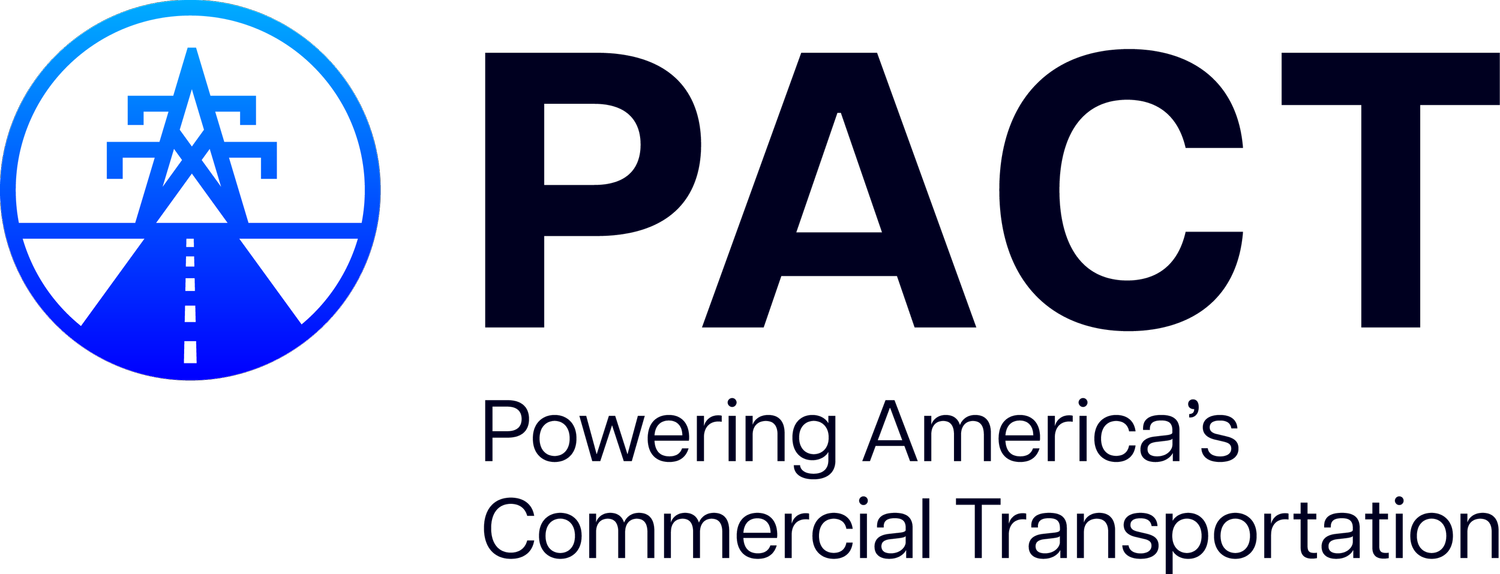PACT Coalition’s ZEV Infrastructure Action Plan
“Medium- and heavy-duty electric truck deployments are increasing, but the private sector can’t go it alone.”
The U.S. economy and heavy-duty trucks are inextricably linked. Over 70% of goods travel by truck. Without them, our supermarket shelves would be nearly empty in just two to three days. At the same time, medium- and heavy-duty (M/HD) trucks contribute nearly 8% of the country’s emissions.
But trucks are not disproportionate polluters — they emit under 100 grams of CO2 per ton-mile compared to passenger vehicles, which emit about 400 grams per mile. They are, however, disproportionate workers, responsible for nearly 7% of the country’s GDP. It is due to our economy’s outsized reliance on M/HD trucks that makes them a critical piece of the energy transition puzzle.
The good news is that the commercial freight sector is making progress toward emissions reduction. According to S&P Global Mobility, approximately 8,500* Class 6-8 zero-emission vehicles (ZEVs) are on the road today. Deployments are increasing, but the private sector can’t go it alone. Progress will stall if the necessary energy infrastructure is not made available in an affordable manner–and fast.
Innovative policy, favorable regulation, and deep collaboration across all private and public sectors of our economy are needed to electrify America’s transportation system. That is why the country’s leading medium- and heavy-duty truck manufacturers, fleet owners and operators, and infrastructure developers and providers have come together to form Powering America’s Commercial Transportation (PACT) and push for the accelerated deployment of the charging infrastructure needed to operate electric heavy-duty trucks.
To achieve our collective goals, PACT members are committed to:
Building a Strong Commercial Zero Emission Vehicle Economy
More federal, state, and local funding is needed to drive medium- and heavy-duty electric truck adoption. PACT advocates for policies and programs that direct public funding and tax incentives to both vehicle purchase programs and infrastructure development, such as “make ready programs” for electric utilities. Importantly, funding medium- and heavy-duty zero-emission vehicle infrastructure projects must support the myriad of existing and emerging charging models, including public access stations, multi-tenant sites, and behind-the-fence solutions.
Streamlined and expedited permitting and zoning procedures are also much needed to expand charging infrastructure deployments for medium- and heavy-duty electric trucks (EVs). For example, if a single charging site developer wanted to install 20 chargers in 10 different jurisdictions, it would have to go through 10 unique permitting processes, and potentially modify its designs 10 different ways to ensure that they complied with local regulations. PACT works to break down costly bureaucratic barriers that delay access to power for electric trucks.
Readying The Grid For Big Time Big Rig Demand
Building charging infrastructure for medium- and heavy-duty electric trucks is hugely different from building charging infrastructure for consumer EVs, often requiring significant grid upgrades that can take up to 10 years. This timing is at odds with national and state zero-emission vehicle sales and purchase mandates and stands to delay America’s path to net zero. To help keep the country’s transportation electrification target on track, PACT pushes for policies that prioritize accelerated energization timelines for medium- and heavy-duty zero-emission vehicle infrastructure projects, and promotes fair rate designs and cost recovery mechanisms to ensure customers and utilities share the cost of the transition in a reasonable way.
PACT also strongly encourages proactive grid upgrades in areas expected to see increased charging demand and the inclusion of medium- and heavy-duty electric truck demand in utility forecasting and resource planning. This isn’t just good for commercial vehicles, it's a boon for grid reliability, and by providing industry access to reliable grid capacity data, we can support these efforts.
Making the Energy Transition a Win-Win for Everyone
The commercial transportation industry and the power sector must work together to enable rapid, reliable, and affordable charging infrastructure deployments for medium- and heavy-duty electric trucks. PACT works closely with policymakers, regulators, grant agencies, utilities and grid operators, social and environmental justice groups, and more to grow the market for medium- and heavy-duty electric trucks nationwide.
—
America must decarbonize for the greater good. To achieve our national net-zero goals, the market for medium and heavy-duty (M/HD) electric trucks must be able to grow. PACT was established to serve as a convener of transportation electrification stakeholders and is already hard at work. Our members are committed to a zero-emission future and believe that, through advocacy, education and deep collaboration, we can meet our collective goals on time.
We welcome you to join us in our efforts.
* https://www.epa.gov/greenvehicles/greenhouse-gas-emissions-typical-passenger-vehicle#:~:text=including%20the%20calculations.-,How%20much%20tailpipe%20carbon%20dioxide%20(CO2)%20is%20emitted%20from,GHG)%20emissions%20from%20a%20vehicle
https://www.govinfo.gov/content/pkg/FR-2016-10-25/pdf/2016-21203.pdf

